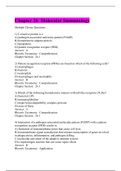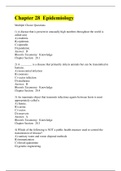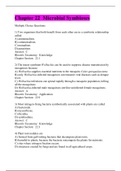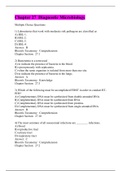BIOL 1030 (BIOL 1030)
Schoolcraft College
All 4 results
Sort by

-
Chapter 26 Molecular Immunology,100% CORRECT
- Exam (elaborations) • 26 pages • 2021
-
- $16.49
- + learn more
C-reactive protein is a A) pathogen-associated molecular pattern (PAMP). B) homotrimeric adaptor protein. C) lipoprotein. D) pattern recognition receptor (PRR). 2) Pattern recognition receptors (PRRs) are found on which of the following cells? A) macrophages B) bacteria C) neutrophils D) macrophages and neutrophils 3) Which of the following biomolecules interact with toll-like receptors (TLRs)? A) bacterial LPS B) immunoglobulins C) major histocompatibility complex proteins D)...

-
Chapter 28 Epidemiology,100% CORRECT
- Exam (elaborations) • 25 pages • 2021
-
- $17.49
- + learn more
1) A disease that is present in unusually high numbers throughout the world is called a(n) A) endemic. B) epidemic. C) sporadic. D) pandemic. 2) A ________ is a disease that primarily infects animals but can be transmitted to humans. A) nosocomial infection B) zoonosis C) vector infection D) mudurane 3) An inanimate object that transmits infectious agents between hosts is most appropriately called a A) fomite. B) carrier. C) vector. D) reservoir. 4) Which of the following ...

-
Chapter 22 Microbial Symbioses,100% CORRECT
- Exam (elaborations) • 30 pages • 2021
-
- $17.49
- + learn more
Two organisms that both benefit from each other are in a symbiotic relationship called A) ammensalism. B) commensalism. C) mutualism. D) parasitism. 2) The insect symbiont Wolbachia can be used to suppress disease transmission by mosquitoes because A) Wolbachia supplies essential nutrients to the mosquito Culex quinquefasciatus. B) only Wolbachia-infected mosquitoes can transmit viral diseases such as dengue fever. C) Wolbachia infections can spread rapidly through a mosquito popula...

-
Chapter 27 Diagnostic Microbiology ,100% CORRECT
- Exam (elaborations) • 24 pages • 2021
-
- $18.49
- + learn more
Laboratories that work with moderate risk pathogens are classified as A) BSL-1. B) BSL-2. C) BSL-3. D) BSL-4. 2) Bacteremia is a term used A) to indicate the presence of bacteria in the blood. B) synonymously with septicemia. C) when the same organism is isolated from more than one site. D) to indicate the presence of bacteria in the lungs. 3) Which of the following must be accomplished FIRST in order to conduct RT-PCR? A) Complementary DNA must be synthesized from double-strande...

$6.50 for your textbook summary multiplied by 100 fellow students... Do the math: that's a lot of money! Don't be a thief of your own wallet and start uploading yours now. Discover all about earning on Stuvia


